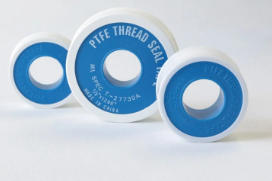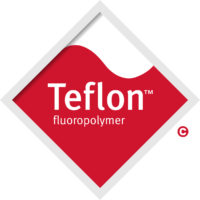What is the most common PTFE tape?
The most common PTFE Tape and the number one search engine suggestion is known as “PTFE Pipe thread tape” or “plumbers’ tape” which is primarily used in plumbing applications on pipes, tubes, or conduits as a lubricating seal tape to prevent water and air leakage. PTFE Thread seal tape conforms to pipe threads acting as a “gap” filler, and the non-stick PTFE properties provide lubrication to the threads allowing for ease of installation when securing fasteners. If you have used this type of PTFE tape, you have seen how far thread tape can stretch before it breaks, but have you ever wondered why? It is because PTFE thread seal tape exhibits extremely high “elongation” (remember this term, its important!). PTFE thread seal tape can be stretched to almost 50% of it’s initial composure, enabling the tape to wrap and conform around threaded components. A common reason why most plumbing “DIY’s” recommend using scissors to cut the tape instead of stretching or pulling the tape until it breaks. PTFE thread seal tape has the highest conformity out of all types of PTFE Tape. Almost all types of PTFE tape consist of elongation properties to improve conformability, especially when utilized in wrapping applications.
What is PTFE?
PTFE, also known as Polytetrafluoroethylene is a well-known fluoropolymer among various industries by the trade name “Teflon” by Chemours. Many of us can associate Teflon™ with cookware, most recognizable as PTFE coated pans for their nonstick release properties. Debatably, one could say the PTFE coating on nonstick cookware was developed to replace or limit the need for fatty cooking oils that affect our cholesterol. PTFE is a fluoropolymer super slippery and extremely temperature resistant, and chemically inert. These fluoropolymers have distinguished themselves as an ideal coating for numerous applications in various industries ranging from cookware to aerospace flight components. However, PTFE is not only used as a coating; it can also be manufactured into different grades. When coupled with additional additive properties to create “Modified PTFE”, or in different forms like molded parts, solid heavy gauge sheets, skived films, rods, bars, and adhesive-backed tapes. It can also be combined with different polymers to create performance manufactured products. Please continue on to learn more about the different forms and applications discussed in this guide.
What properties differentiate the types of PTFE Tape?
Understanding each PTFE tapes physical properties can help distinguish them. Their different characteristics offer different functionalities when using or applying them in your application.
Typical PTFE Tape Properties Characteristics:
Elongation: a measurement that shows how much a material can be stretched before it breaks.
Tensile Strength: the resistance of a material to breaking under tension. Mostly measured in pounds per inch values.
| Type of PTFE Tape | Elongation (%@break) ASTM D 3759 | Tensile Strength (lbs./in.) ASTM D 3759 |
| Skived PTFE Tape | 300 % | 30 |
| High Density PTFE Tape | 100% | 22 |
| T-Series PTFE Tape (3 mil.) | 275% | 25 |
| FST PTFE Tape | 100% | 40 |
| R233 (3 mil.) | 150% | 40 |
What are the types of PTFE Tape?
While recognizing the importance of search engines, it needs to be noted there are various other types of performance PTFE tapes that can be used in industries like packaging, electronics, manufacturing, and aerospace. The most common types of PTFE tape include skived, calendared, extruded, coated, and laminated. What characterizes the different types of PTFE tape is the manufacturing process utilized to produce them. These processes are what give PTFE tape superior performance characteristics like high density, elongation, and tensile strength. The adhesive backing is composed of either silicone or acrylic adhesive.
Skived PTFE Tape– consists of PTFE billets or blocks shaved or “skived” to achieve the nominal film thickness. In example, think of an old-style spindle potato peeler, the potato is placed on a hand cranked spindle while a spinning knife is held against the potato to peel its outer layer. Skived PTFE shares a similar process but incorporates a high torque motorized shaft that is spun against a fixed blade across the full width of the PTFE billet to achieve a desired film thickness. After skiving is complete PTFE film then goes through a treating process to enable an adhesive coating to be placed on the film, creating Skived PTFE tape.
Benefits of skived PTFE:
- Made from Natural Skived PTFE Film
- Available as thin as .0005″, and in thicker gauges up to .125”
Calendared PTFE Tape– This refers a process that melts PTFE polymers into a sheet or film. This done by a machine utilizing high heat and hard pressure rollers to compress and mold the PTFE into the desired film thickness.
Benefits of calendared PTFE:
- Smooth surface quality
- Reduced Skive Lines
- Great thickness accuracy
PTFE Coated Tape– These types of PTFE tapes are commonly made up of fiberglass fabric substrates that are dispersion coated with Teflon™ PTFE. These are made from tightly woven fiberglass fibers that provide dimensional stability while the PTFE coating provides a slippery, anti-friction release surface. There are two universal grades of PTFE coated fiberglass tapes, standard or ultra-premium grade. These types are individualized by the grade of woven fiberglass fibers and the amount of PTFE coating. These tapes utilize two adhesive backing systems in either silicone or acrylic adhesive. Silicone is frequently used for high temperature applications or applications that require easy removability and clean release. Acrylic is used for applications that require stronger bonding adhesion or a higher initial tack adhesion. A specialty tape known as “Zone Tape” is a PTFE coated fiberglass tape that is used for applications that require adhesive on only certain parts of the tape leaving the center of the tape as the non-adhesive “free zone”.
Laminated PTFE Tape– These types of PTFE tapes utilize the same fiberglass fibers as PTFE coated fiberglass tapes; however PTFE is laminated on to the fiberglass creating a more durable and longer lasting surface. Laminated PTFE tapes are more flexible and have an extended application life compared to traditionally coated PTFE tapes.
How PTFE tapes can be used in applications
PTFE’s versatile performance properties including non-stick release, high temperature, water and chemical resistance, and dielectric strength enable PTFE tapes to be used in a variety of applications. These properties help to improve performance where physical characteristics are important. Common PTFE Tape applications include wrapping, insulating, separating or gap filling.
For conformable applications, high-density PTFE, R-Series, or FST Tape are ideal choice for these types of applications. Their low elongation properties and special manufacturing processes make them ideal for wrapping applications. For example, high-density PTFE can be used for high temperature insulation applications. Skived HD PTFE Tape meets MIL-I-23594C U.S. Government specifications and is commonly used in aerospace applications to wrap airframe wire harnesses. R-Series PTFE tape can be used to wrap neoprene drive rollers on conveyor systems as it does not curl or wrinkle. Due to it high tensile strength and toughness, FST tape can also be used as roller protection wrapping. This tape is commonly used in flat die extrusion of polyethylene coatings and other lamination applications.
For insulating or masking applications, skived PTFE is recommended for its superior insulating strength, release properties as well as chemical and temperature resistance. Standard skived tapes are highly conformable with 300% elongation, perfect for masking applications to conform around corners and edges. For gap filling, separating, or insulating materials thick gauge “FAT” PTFE tape (.020”-.125”) can be used to create dielectric insulation, a high temperature barrier, or a non-stick separator. Skived PTFE tape has high dielectric strength which makes it ideal as an insulator in electronic applications.
For applications requiring durability coupled with non-stick properties, PTFE coated fiberglass tape or PTFE laminate tape are recommended. PTFE Fiberglass tapes are commonly used in packaging applications on form/fill/seal machines to cover hot wires or heat-sealing jaws. They are also used on conveyor systems as release liners to eliminate friction on high traffic areas. These PTFE fiberglass tapes are very versatile and CS Hyde recommends this product as diaphragm gasket material due the dimensional stability of the fiberglass and PTFE’s release properties.
“Teflon™ is a trademark of The Chemours Company FC, LLC used under license by CS Hyde Company.”



